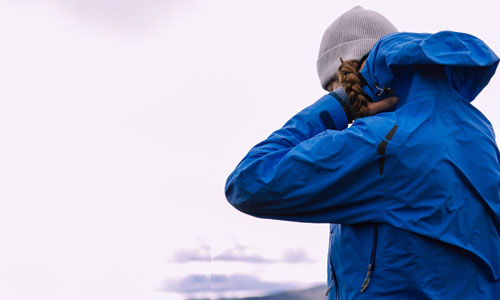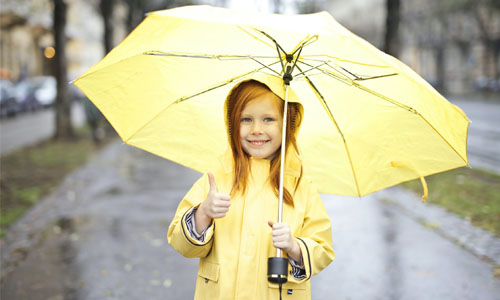Waterproof Jackets: The Tech That Goes Inside Making It
Author

Chris shares his passion for cycling, hiking, skiing, and climbing from Buxton, in the Peak District. As a blogger for Outdoor Look, Chris shares outdoor tips and indoor tricks to help you get the most out of your time spent outside. When he's not out adventuring he's making videos or trying to keep up with his 4-year-old son.
Waterproof jacket is one of the most popular winter wear. It is warm, comfortable and most importantly, it keeps you safe from the rain and blizzards. Have you ever wondered what it takes to make these waterproof jackets an all-around star? No, right?
A lot of technology and thought goes into the process of making a waterproof jacket and understanding what lies beneath that fabric, is the most important step in deciding, which jacket to buy for yourself.

Fabric Construction
First things first, to understand what lies beneath, you have to learn what it is made of- layer by layer. The quantity of layer with which the waterproof jacket is made, tells a lot about the construction of the fabric.
In a 2-layer fabric, the construction is mainly done with waterproof membrane and face fabric. These materials are often sewn in with a fabric lining or a mesh to increase comfort. When you buy a 2-layer fabric jacket, it is the most affordable of the lot, which also makes it less breathable as well. There are also 2.5- and 3-layer fabrics. These two types are better than the 2-layer fabric with more durable, breathable, and comfortable characteristics. It is the back and face fabric that affect the characteristics of the jacket mostly.
- Fabric with Laminates and Coatings
Laminated fabrics are made with a thin waterproof membrane that is bonded to a shell fabric. They are a lot more comfortable, durable and breathable, and high performing than the coated fabric. Also, coated fabrics are a lot more affordable than laminated fabrics.
Moisture Vapour Transmission Rate
Breathability of a water jacket is closely related to its comfort. In other words, a jacket will not be comfortable, if it is not breathable enough. When you are exercising, moisture or sweat is created that requires a means to escape. A jacket that has a high level of breathability will wick the moisture and will not let you feel wet or sticky.
Other factors that influence the breathability of your jacket are, humidity, pockets (as they add another layer), air permeability, and dirt and abrasion.
Durable Water Repellent (DWR) Coatings
One of the most common features of water repellent and waterproof jackets is the DWR coating that stops the water from sitting on the jacket and getting absorbed. With the help of the coating, the water droplets just roll out keeping the integrity of the jacket intact. Also, if the water gets absorbed by the fabric, the jacket will feel heavier and more uncomfortable when you wear it. It is important to remember that regular cleaning and reproofing of a jacket will keep the DWR coating intact and continue to repel water.

Difference between Water Resistant and Waterproof Jacket
There has been a fair amount of debate on waterproof and water-resistant jackets. Well, the simple explanation is, a waterproof jacket is designed with some type of membrane built in the jacket with a coating on the outer surface that repels water thoroughly even when it is pouring down. On the other hand, a water-resistant jacket repels water to a certain extent and in a downpour, you will eventually get wet.
A Better Option
If you are wondering, which one to invest in, then, buying a good quality waterproof jacket will pay off in the long run. They are made with highly comfortable fabric and for rigorous activity, there is no better replacement than a waterproof jacket to keep you warm, dry, and safe from the outside elements.
Author

Chris shares his passion for cycling, hiking, skiing, and climbing from Buxton, in the Peak District. As a blogger for Outdoor Look, Chris shares outdoor tips and indoor tricks to help you get the most out of your time spent outside. When he's not out adventuring he's making videos or trying to keep up with his 4-year-old son.
- Speed Up Your Post-Hike Recovery with These 6 Essential Tips
- Cycling through Tranquil Roads and Coastal Views on the Isle of Wight
- The Essential Guide to Hiking Safety: 5 Tips Every Hiker Should Know
- Run Smart, Run Strong: Your Guide to Injury-Free Running
- Embrace Biking: Essential Tips for Beginners
Categories
- Sport (28)
- Product Reviews (3)
- Team Outdoor Look (7)
- Mike Wild (2)
- Mike Payton (2)
- Suse Hammond-Pears (3)
- Snowboarding (12)
- Latest Offers (105)
- Shop Talk (1)
- Competitions (7)
- Walking (413)
- Lifestyle Fashion (8)
- Travel (86)
- Kit Guides (176)
- Workwear Clothing (6)
- Safety Workwear (4)
- Health/Fitness (289)
- Skiing (91)
- Great Outdoors (1316)
- Cycling (92)
- January 2025
- December 2024
- November 2024
- October 2024
- September 2024
- August 2024
- July 2024
- June 2024
- May 2024
- April 2024
- March 2024
- February 2024
- January 2024
- December 2023
- November 2023
- October 2023
- September 2023
- August 2023
- July 2023
- June 2023
- May 2023
- April 2023
- March 2023
- February 2023
- January 2023
- December 2022
- November 2022
- October 2022
- September 2022
- August 2022
- July 2022
- June 2022
- May 2022
- April 2022
- March 2022
- February 2022
- January 2022
- December 2021
- November 2021
- October 2021
- September 2021
- August 2021
- July 2021
- June 2021
- May 2021
- April 2021
- March 2021
- February 2021
- January 2021
- December 2020
- November 2020
- October 2020
- September 2020
- August 2020
- July 2020
- June 2020
- May 2020
- April 2020
- March 2020
- February 2020
- January 2020
- December 2019
- November 2019
- October 2019
- September 2019
- August 2019
- July 2019
- June 2019
- May 2019
- April 2019
- March 2019
- February 2019
- January 2019
- December 2018
- November 2018
- October 2018
- September 2018
- August 2018
- July 2018
- June 2018
- May 2018
- April 2018
- March 2018
- February 2018
- January 2018
- December 2017
- November 2017
- October 2017
- September 2017
- August 2017
- July 2017
- June 2017
- May 2017
- April 2017
- March 2017
- February 2017
- January 2017
- December 2016
- November 2016
- October 2016
- September 2016
- August 2016
- July 2016
- June 2016
- May 2016
- April 2016
- March 2016
- February 2016
- January 2016
- December 2015
- November 2015
- October 2015
- September 2015
- August 2015
- July 2015
- June 2015
- May 2015
- April 2015
- March 2015
- February 2015
- January 2015
- December 2014
- November 2014
- October 2014
- September 2014
- August 2014
- July 2014
- June 2014
- May 2014
- April 2014
- March 2014
- February 2014
- January 2014
- December 2013
- November 2013
- October 2013
- September 2013
- August 2013
- July 2013
- June 2013
- May 2013
- April 2013
- March 2013
- February 2013
- January 2013
- December 2012
- November 2012
- October 2012
- September 2012
- August 2012
- July 2012
- June 2012
- May 2012
- April 2012
- March 2012
- February 2012
- January 2012
- December 2011
- November 2011
- October 2011
- September 2011
- August 2011
- May 2010
- April 2010
- March 2010
- February 2010
- January 2010
- November 2009
- October 2009
- September 2009
Submit a Comment